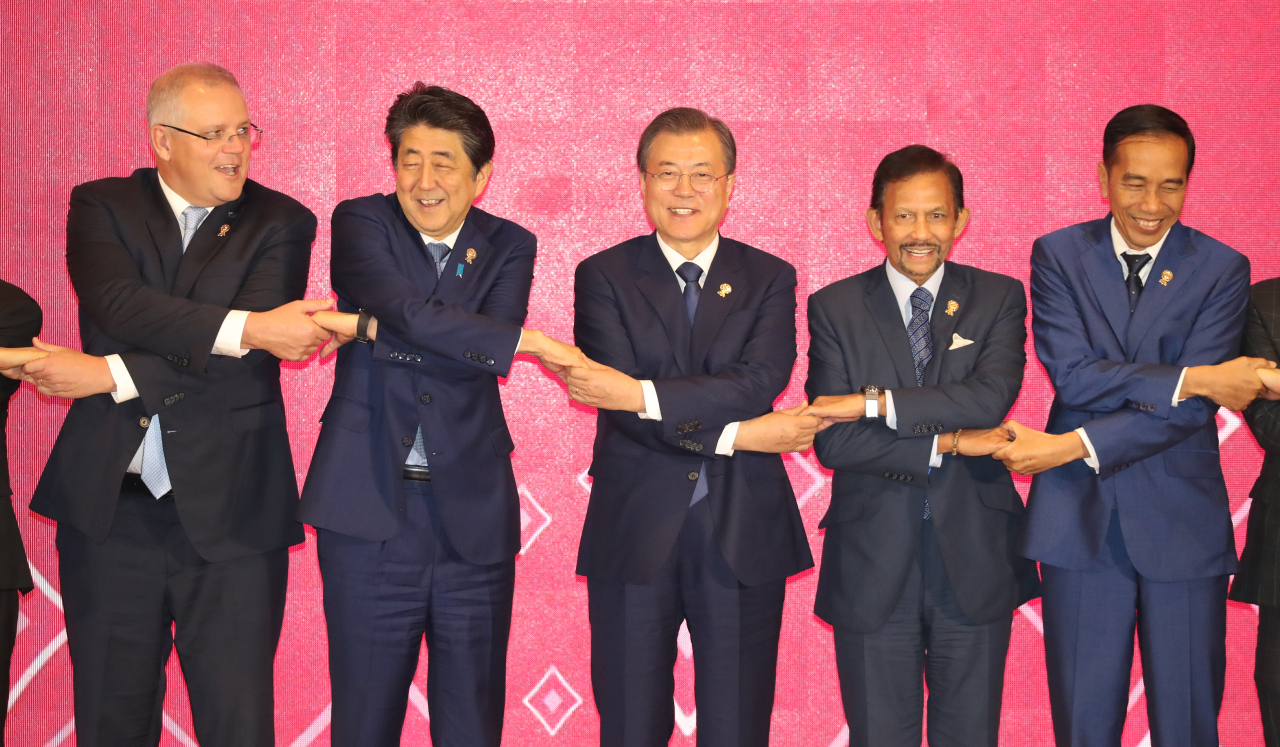The trade megadeal among 15 Asia-Pacific countries can be expected to provide South Korean exporters with new opportunities to enter fast-growing and promising markets in Southeast Asia and lay the foundation for a future trade bloc consisting of Korea, Japan and China, according to experts.
After seven years of negotiations, the leaders of 15 nations reached agreement on Monday on all 20 chapters of the Regional Comprehensive Economic Partnership and expressed their willingness to sign it in 2020.
The RCEP is a massive regional trade deal among the 10 members of the Association of Southeast Asian Nations and the six countries with which ASEAN has free trade agreements -- Korea, China, Japan, India, Australia and New Zealand.
After seven years of negotiations, the leaders of 15 nations reached agreement on Monday on all 20 chapters of the Regional Comprehensive Economic Partnership and expressed their willingness to sign it in 2020.
The RCEP is a massive regional trade deal among the 10 members of the Association of Southeast Asian Nations and the six countries with which ASEAN has free trade agreements -- Korea, China, Japan, India, Australia and New Zealand.

A day after the declaration, Industry Minister Sung Yun-mo convened a meeting with business associations and trade organizations to discuss the deal’s impact on the nation’s economy and its importance to industries.
“Amid a severe decline in the nation’s exports, the RCEP will improve the export environment for Korean companies by improving market access and diversifying trade in the region,” said Sung.
The RCEP region is a massive market, accounting for 32 percent of the world’s gross domestic product, 48 percent of its population and 29 percent of global trade as of last year, according to the International Monetary Fund.
Minister Sung went on to say that the RCEP agreements incorporated an e-commerce chapter, reflecting the advent of the digital economy and cementing the foundation for Korean firms to enter the rapidly growing ASEAN e-commerce market. The e-commerce sector was not included in the Korea-ASEAN free trade deal, which took effect in June 2007.
The regional trade deal may also lay the foundation for a future trade bloc composed of Korea, Japan and China, which are so close, yet so far, experts say.
“The two nations are key neighboring countries to Korea, which has retained its economic structure by utilizing Japan’s technologies and capital goods and China’s labor and markets to export goods to the US and Europe,” said Song Ki-ho, a partner attorney at SoorunAsia Law, a firm that specializes in international trade.
Despite the significance of the relationship, the three countries have found it challenging to form a trilateral pact due to complicated historical, political and economic issues, with China in particular having a different approach to the market economy.
“The trade partnerships among the three nations will continue for some time within regional trade deals with other nations, rather than their own trade deal. But the RCEP means a great deal to the three neighboring countries,” Song said.
Since March 2013, there have been 15 rounds of negotiations toward a Korea-China-Japan FTA. But so far, the progress of the negotiations has been disappointing due to disagreements in many areas.
If a trade deal among the three nations were sealed, the trade volume would account for around 19 percent of the world’s total trade, making it the third-largest trade bloc, surpassed only by the European Union and North America.
By Shin Ji-hye (shinjh@heraldcorp.com)







![[KH Explains] How should Korea adjust its trade defenses against Chinese EVs?](http://res.heraldm.com/phpwas/restmb_idxmake.php?idx=644&simg=/content/image/2024/04/15/20240415050562_0.jpg&u=20240415144419)












![[Today’s K-pop] Stray Kids to return soon: report](http://res.heraldm.com/phpwas/restmb_idxmake.php?idx=642&simg=/content/image/2024/04/16/20240416050713_0.jpg&u=)